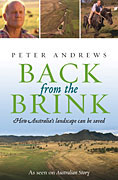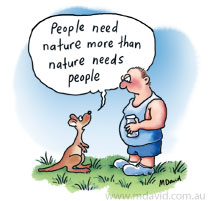
I’ve often heard it said that Australia had plenty of water, but that much of it was underground. After reading Back from the Brink I see that in a whole new light.

BOOK REVIEW
Back from the Brink
By Peter Andrews
Published by ABC Books. 244 pages
Review by Mark David
Stare out the window during a flight across Australia and chances are you’d be
looking onto a dry, vast expanse of orange-brown earth. You might occasionally see a river,
highlighted by a narrow band of gum trees along its edges. Meanwhile the river carves a deep
channel separating sheets of dry and mostly unproductive ground.
It’s not the most efficient way of utilising the land in Australia and it didn’t work like that before we humans got here. And if some of our attitudes don’t change then we could be headed for major problems with salinity, drought, and widespread crop failure.
Peter Andrews is the guy you might have seen on the ABC TV show, Australian Story. He’s written a remarkable book, in which he shares his insights into how things appear to have turned out this way. He describes how a country with so little rain thrived for millions of years, thanks to a self-supporting system of floodplains and rivers that were more a string of ponds than the deep channels gouged into the landscape which we know today. He talks about how water flowed very slowly downhill through the soil, hydrating plants along the way and losing almost nothing to evaporation, instead of rushing down deep river channels to escape out to sea. He describes how salt used to sit immobile under a ‘lens’ of fresher water, and explains how interfering with this system without understanding it has caused the salt to be displaced, where it moves laterally, eventually breaking through to the surface, at which point the moisture evaporates and the salt left behind reaches truly destructive concentrations.
More importantly, he offers insights into how to restore moisture and fertility to the land while at the same time addressing that very serious problem of salinity. I know it sounds too good to be true, and sure enough, the book does challenge many established beliefs about farming practices, irrigation and land management. But when you think about it, just where have those established farming methods and beliefs got us? They got us into the mess we’re in today, where irrigators are crying out for more water, salinity is destroying our ability to grow crops, land is becoming less fertile and entire river systems are on the verge of failing.
In my opinion, one part of the reason for the problem we are facing is the bias we have as humans. We are visual creatures. And so when we try to manage water we first of all want to see it. So we prefer to see water flowing down rivers, despite the fact that this accelerates its removal from the system. We like to see the water we spray over the surface of the land when we irrigate, despite the fact that the fibrous plant roots which absorb water grow in the soil rather than above it. As visual creatures we tend not to trust or even believe what we can’t see. But one thing even the loudest sceptics can see is the result of Andrews’ land management, and that is productive, fertile and profitable land.
I won’t try to explain Andrews’ ideas. That would take a book, or perhaps a few of them. And of course Andrews has already written one. But after reading Back from the Brink I can perhaps offer some clues about what he is saying and also what he isn’t.
First of all, he is not completely anti-irrigation. But he does suggest what sound like some very logical ideas to change our approach to it.
Also, contrary to what some of his critics say, he is not suggesting Australia switches from growing useful crops to nothing but weeds. Instead, what he does teach us is how “weeds” can be fantastically useful as part of a cycle during which fertility is restored to the land while also managing salinity. He describes a system of dividing properties into thirds, which enhances the overall productivity of a farm in a sustainable way, while saving a heap of dollars on artificial fertilisers and herbicides.
Finally, although he shares a lot in common with organic farmers, he does see some place for the intelligent use of some chemicals and artificial fertilisers, and stresses the benefits which come from biodiversity in ways which many organic farmers appear to ignore.
In my opinion this is an important book. One of those, ‘Oh, now I get it!’ types of books. If I have confused you, or worse still, misrepresented his ideas, then that is my fault and I apologise for it. So perhaps the best thing for you to do is read it for yourself!






